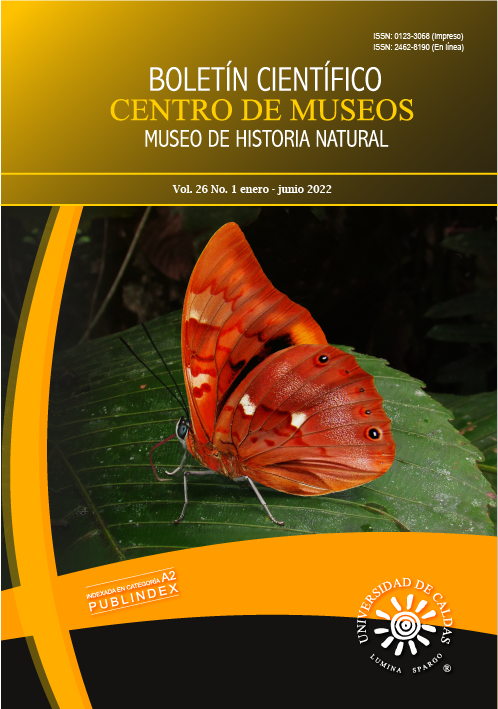Authors
Abstract
The Pleidae family is distributed worldwide and includes four genera, about 38 species and one subspecies. In South America, this group is represented by three genera: Neoplea, Paraplea and Heteroplea. In Colombia, the two first genera are registered, but knowledge of their distribution in the national territory is still incipient. Objective: To expand the knowledge of the Pleidae in Colombia by reporting new geographic records. Methodology: Entomological material from different research projects deposited in the Colección Entomológica del Programa de Biología de la Universidad de Caldas (CEBUC) was reviewed and secondary information was collected with records of Pleidae in Colombia. Results: As a result, the genus Neoplea is registered for the first time for the departments of Caldas and Tolima, and its distribution is also expanded in the department of Córdoba . Two species are reported in this work: N. maculosa and N. semipicta. The first species is registered only in Córdoba and the second one in the three mentioned departments. Conclusion: This work broadens the knowledge of the Pleidae of Colombia and also highlights the importance of biological collections.
Keywords:
References
Bachmann, A. O.& López-Ruf, M. L. (1994). Los Pleoidea de la Argentina (Insecta: Hemiptera). Fauna de agua dulce de la República Argentina,35(3), 1-32.
Barbosa, J.F. & Rodrigues, H.D.D. (2015). The true water bugs (Nepomorpha). En Panizzi & Grazia (Ed.). True bugs (Heteroptera) of the Neotropics (pp. 159-199) (Vol. II). Sociedade Entomológica do Brasil.
Berchi, G. M., Petrovici, M., & Ilie, D. M. (2011). Aquatic and semiaquatic true bugs (Heteroptera: Nepomorpha) of Cefa Nature Park (North - Western Romania). Analele Universitatii din Oradea Fascicula Biologie, 18(1), 29-33.
Cook, J. L. (2011). A new genus and species of Pleidae (Hemiptera) from Venezuela, with notes on the genera of Pleidae. Zootaxa, 3067(1), 26-34.
Cook, J. L., Mondragón-F, S. P., & Morales, I. (2020). Description of two new species of Neoplea Esaki & China (Hemiptera: Pleidae) from Colombia. Zootaxa, 4860(1), 055-066.
Cuadrado-Argel, L. A., Solano-Sánchez, M. C., & Garcés-Villalba, J. D. (2011). Comunidad de dípteros, hemípteros y odonatos de la Ciénaga de Betancí (Córdoba-Colombia). Actualidades Biológicas, (1), 186-189.
Deler-Hernández, A., Megna, Y. S., González-Lazo, D. D.& Cracasés-Torres, C. N. (2007). Insectos acuáticos y áreas prioritarias para la conservación en la cuenca alta del Río Cauto (Santiago de Cuba, Cuba). Boletín de la Sociedad Entomológica Aragonesa, 40, 451-461.
Forero-Céspedes, A. M., Reinoso-Flórez, G.& Gutiérrez, C. (2013). Evaluación de la calidad del agua del río Opia (TolimaColombia) mediante macroinvertebrados acuáticos y parámetros fisicoquímicos: water quality assessment of the Opia River (Tolima-Colombia), using macroinvertebrates and physicochemical parameters. Caldasia, 35(2), 371-387.
Gil, D. N. P. (2012). Los hemípteros acuáticos del municipio de Tumaco (Nariño, Colombia): guía ilustrada. Editorial Universitaria, Universidad de Nariño.
Grandova, M. A. (2013). Aquiatic Heteroptera (Nepomorpha, Guerromorpha) in small intermittent rivers of Ukraine steppe zone. En Popov A, Grozeva S, Simov N, Tasheva E (Eds) Advances in Hemipterology.Zookeys, 319, 107-118.
Heckman, W.C. (2011). Encyclopedia of South American Aquatic insects: Hemiptera - Heteroptera. Olympia Washington, USA.
Holdridge, L. R. (1987). Ecología: basada en zonas de vida Life zones ecology. Instituto Interamericano de Cooperación para la Agricultura, IICA (No. IICA-LME 83 IICA-LME 34). IICA, San José (Costa Rica).
Hernández, J. I., Hurtado, A., Ortiz, R. & Walschburger, T. (1992). Unidades Biogeográficas de Colombia: 105 - 152 En Halffter, G. (Ed.) La Diversidad Biológica en Iberoamérica. Revista Acta Zoológica Mexicana, Volumen Especial 1992.
Mazzucconi, S. A., Ruf, M. L., & Bachmann, A. O. (2008). Gerromorpha y Nepomorpha (Insecta: Heteroptera) del Parque Provincial Salto Encantado del Valle del Cuñá Pirú, Provincia de Misiones, Argentina. Lundiana: International Journal of Biodiversity, 9(1), 57-66.
Melo, M. C., Dellape, P. M., Carpintero, D. L., & Montemayor, S. I. (2011). Heteroptera (Hemiptera) from the Chaco National Park (Argentina). Zootaxa, 2999(1), 1-19.
Morales-Castaño, I. T., & Rendón, F. M. (2008). Aquatic Heteropterans of Quindío (Colombia): The infraorders Gerromorpha and Nepomorpha. Revista Colombiana de Entomología, 34(1), 121-128.
Nieser, N. (2004). Guide to aquatic Heteroptera of Singapore and peninsular Malaysia III. Pleidae and Notonectidae. Raffles Bulletin of Zoology, 52, 79-96.
Padilla-Gil, D. N. (2013). New records and distribution expansions of aquatic heteropterous from colombia (hemiptera, heteroptera). Acta Biológica Colombiana, 18(2), 391-400.
Pennington, R. T., Lavin, M., & Oliveira-Filho, A. (2009). Woody plant diversity, evolution, and ecology in the tropics: perspectives from seasonally dry tropical forests. Annual Review of Ecology, Evolution, and Systematics, 40, 437-457.
Papáček, M. (2013). Small aquatic and ripicolous bugs (Heteroptera: Nepomorpha) as predators and prey: The question of economic importance. European Journal of Entomology, 98, 1-12.
Pérez-Bilbao, A., Benetti, C. J., & Garrido, J. (2012). Nuevas aportaciones al conocimiento de los heterópteros acuáticos (Heteroptera: Gerromorpha y Nepomorpha) en humedales de Galicia (NO España). Boletín de la Asociación Española de Entomología, 36, 87-107.
Polhemus, J. T., & Polhemus, D. A. (2007). Global diversity of true bugs (Heteroptera; Insecta) in freshwater. En Freshwater animal diversity assessment (pp. 379-391). Springer, Dordrecht.
Roback, S. S., & Nieser, N. (1974). Aquatic Hemiptera (Heteroptera) from the llanos of Colombia. Proceedings of the Academy of Natural Sciences of Philadelphia, 126(4), 29-49.
Rondón, C. A. R., Zapata, A. M., Pérez, D., Morales, Y., Ovalle, H., & Álvarez, J. P. (2010). Caracterización limnológica de humedales de la planicie de inundación del río Orinoco (Orinoquía, Colombia). Acta Biológica Colombiana, 15(1), 145-166.
Roldán, G. (1988). Guía para el estudio de los macroinvertebrados acuáticos del Departamento de Antioquia. Universidad de Antioquia, Fondo FEN, Medellín.
Schuh, R. T., & Slater, J. A. (1995). True bugs of the world (Hemiptera: Heteroptera): classification and natural history. Cornell UNIVERSITY press.
SIB (Sistema de información sobre Biodiversidad de Colombia). (2021). http://datos.biodiversidad.co/

 PDF (Español)
PDF (Español)
 FLIP
FLIP
 Perfil Google Scholar
Perfil Google Scholar



















